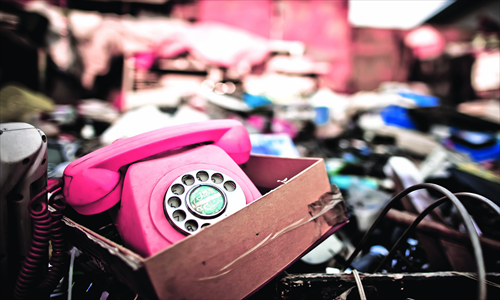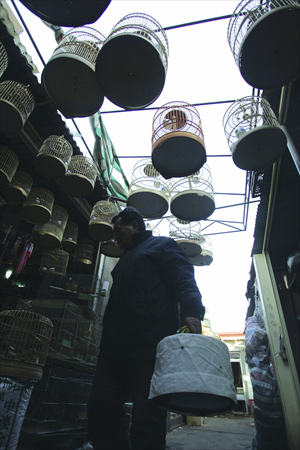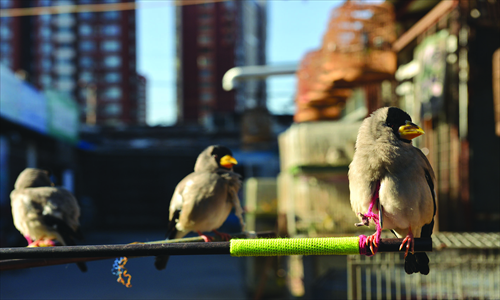Markets bite the dust



Nearly a week after its closure, Aigeleyuan, the largest pigeon market in Beijing, is littered with pieces of cardboard, plastic bags and fruit.
The stores in the area are empty; the iron gates are locked with wrist-sized chains. The entire market is surrounded by a blue fence, separating it from the rest of the street. A large poster is taped to the fence, stating where the market has moved to and providing a cell phone number.
Life went on around the closed market - vendors sold vegetables, clothing and pirated DVDs along the fence - but the market will soon to be demolished and will never again witness the pigeon sales of its prime days.
Located on the narrow street of Caihuying Xijie, Fengtai district, the market was built in 1997 and had over 100 shops. But towards the end of 2012, it was slated for demolition to make way for a new development project, the Lize Financial Business District of Beijing.
Aigeleyuan isn't the first market in the center of the city to disappear under the pressure of urban planning and development. While customers and vendors lament, new projects are still being granted that threaten the existence of such places.
Disappearing markets
Wang Junxiong, a 29-year-old Beijinger, has witnessed the fate of many fading markets. He said to many local residents, such markets represent the culture and history of old Beijing.
"When I was young there were many pet markets, such as Longtanhu, Guanyuan or Shuizhuizi, but these markets have all been moved or rebuilt," he said. "Now even though the environment around these old markets has improved, it feels less like the traditional Beijing."
Another market that has had to relocate is Guanyuan, originally located near the Second Ring Road in Xicheng district. The market sells animals, such as birds, fish or insects and has been popular with Beijingers.
In 2009, Guanyuan market was moved to Zizhuqiao in Haidian district. According to a 2009 Beijing Times report, an official from the Xicheng district government said that area has safety hazards and has been included in a new rezoning plan.
The same fate has fallen on Chengnan Jiuhuo market, where vendors buy and sell everything from used sofas to electric appliances to antique and gadgets. The market was closed down last April.
Li Shi, a member of the Beijing Folk Culture Association, said the market was the biggest second-hand market in Beijing and now it's being developed as part of the Lize Financial Business District and there is no turning back.
"The investment and bidding have all been completed," he said. "The shops were all torn down and there are several business groups from Hong Kong involved."
Disappointing move
Wang Tong has been at the pigeon market for more than four years and sells racing pigeons. Now with the market demolished, he has had to move to a market in Huaxiang Qiaobei, also in Fengtai district. But he said the new address can't compare with the old market.
"The new address is temporary," he said. "It's a little difficult to get an operating license at the new market because it might not allow the buying and selling of birds."
In terms of customers, Wang Tong doesn't know if they'll be able to find him. At the new market, there is no Internet connection, which blocks his primary method of contacting his customers.
Besides, the rent is much more expensive, he said. Even though located within the third ring road, Aigeleyuan started early and offered rent prices of about 20,000 yuan ($3,210) a year for his store. At the new market, it might be twice as expensive, Wang Tong said.
The loss of old markets has brought inconvenience to the vendors as well as customers. Influenced by his father, Wang Junxiong has always had an interest in birds and insects and is familiar with Guanyuan market. In his view, after the move, the market has lost its advantage and its popularity.
"Beijingers don't really recognize the market at Zizhuqiao and the sales there are bleak," he said. "Many vendors come back to Guanyuan to rent apartments in the hutong or sell by the road over the weekend."
Edging with development
Gao Wei, the secretary general of the Beijing Folk Art Association, said disappearing markets is a common phenomenon in modern Beijing.
"This is becoming the mainstream way in many cities, to move the poor who have lived there for centuries away from the city and give the land to the rich," he said.
In the past, there have been reports of safety and sanitation complaints around the old markets, but Gao said that's not the real issue.
"It's an issue of management. Moving the market out of the city doesn't mean sanitation issues will be resolved," he said. "You can't move it because it's out of date."
Gao thinks the designing of an urban space should be according to function. For example, in a commercial district there can be skyscrapers as well as local markets.
"These markets are a representative of the old Beijing's civic culture. If they are all torn down, it would be cultural demolition," he said.